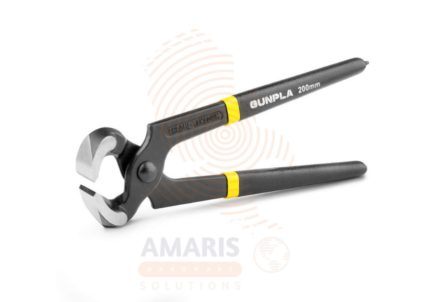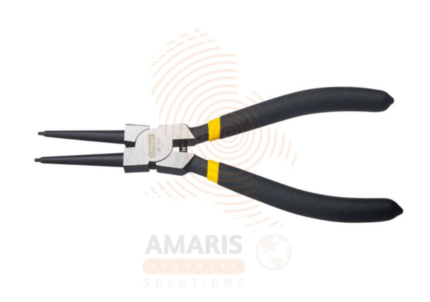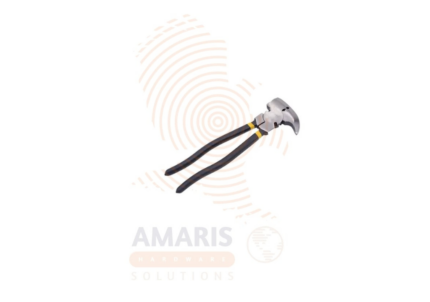Hand Saw
WhatsApp Order
PRODUCT DESCRIPTION
A hand saw is a manual cutting tool with a serrated blade designed for cutting various materials, such as wood, plastic, or metal. It typically consists of a handle at one end and a toothed blade at the other, allowing users to make controlled and precise cuts by moving the blade back and forth through the material. Hand saws come in various types and sizes, each optimized for specific tasks such as crosscutting, rip cutting, or fine woodworking.
Categories: HAND TOOLS, Saws & Blades
Tags: carpentry saw, cutting blade, DIY saw, durable hand saw, hand saw, manual saw, precision cutting tool, woodworking saw, workshop saw
Description
Uses of a Handsaw
- Crosscutting Wood: Hand saws are commonly used for cutting wood across the grain, a task known as crosscutting. This is often done to size lumber or to make shorter pieces from longer ones.
- Rip Cutting: Hand saws are also employed for rip cutting, which involves cutting wood along the grain. This is useful for shaping and sizing lumber lengthwise.
- Trimming and Molding: Hand saws are valuable for precision work, such as trimming and cutting molding or other decorative elements in woodworking projects.
- Pruning Trees and Shrubs: Some hand saws are designed for outdoor use and can be used for pruning trees and shrubs in gardening and landscaping.
- Carpentry and Framing: Hand saws are essential in carpentry and framing work for tasks like cutting studs, rafters, and other framing materials to size.
- DIY Home Projects: Hand saws are practical for various DIY home improvement projects, such as cutting PVC pipes, plastic materials, or lightweight metals.
- Construction Work: Hand saws are used in construction for cutting materials like plywood, particleboard, and other construction-grade wood.
- Emergency Situations: Hand saws can be useful in emergency situations or outdoor activities for cutting through wood, plastic, or other materials when power tools are not available.
- Fine Woodworking: Specialty hand saws, such as coping saws or dovetail saws, are employed in fine woodworking for intricate and detailed cuts, such as those needed for joinery.
- General Purpose Cutting: Hand saws are versatile tools for general purpose cutting tasks where precision and control are required.
SAFETY HANDLING PRECAUTIONS
Safety measures and precautions
- Wear Personal Protective Equipment (PPE):
- Safety Glasses: Protect your eyes from flying debris by wearing safety glasses or goggles.
- Ear Protection: If you're working in a noisy environment, consider using ear protection to prevent hearing damage.
- Dust Mask: When cutting materials that produce dust or particles, wear a dust mask to protect your respiratory system.
- Select the Right Saw for the Job:
- Choose a hand saw that is appropriate for the material and the type of cut you need. Different saws are designed for specific tasks.
- Inspect the Saw:
- Before use, inspect the hand saw for any damage or defects. Ensure that the blade is sharp and in good condition.
- Secure the Workpiece:
- Secure the material you are cutting in a stable manner using clamps or other appropriate methods. This helps prevent the material from moving unexpectedly.
- Maintain a Firm Grip:
- Hold the saw with a firm grip, keeping your hands away from the cutting path. Ensure that your hand placement allows for precise control.
- Use Proper Body Mechanics:
- Stand in a stable position with your feet shoulder-width apart. Maintain balance and use your entire body to control the saw, avoiding awkward postures.
- Start with Light Pressure:
- Apply light pressure initially and let the saw's teeth do the cutting. Avoid forcing the saw, as this can lead to loss of control and accidents.
- Follow the Cut Line:
- Keep the saw aligned with the cut line to ensure accurate cuts. Pay attention to the direction of the cut to prevent the saw from binding.
- Be Aware of Surroundings:
- Be aware of your surroundings and the presence of other people. Communicate with others in the work area to avoid collisions or distractions.
- Store Safely:
- When not in use, store the hand saw in a safe and secure location. Properly cover or sheath the blade to prevent accidental contact.
- Take Breaks:
- If your work involves prolonged use of a hand saw, take regular breaks to prevent fatigue, which can lead to loss of concentration and increased risk of accidents.
- Read and Follow Instructions:
- Familiarize yourself with the manufacturer's instructions and guidelines for using the specific hand saw you are working with.
Related products
Ball Point Hex Wrench Set – Medium
A Ball Point Hex Wrench Set - Medium size typically refers to a collection of nine hexagonal (hex) wrenches designed with ballpoint ends. The term "medium" may refer to the size or thickness of the wrenches, indicating that they are neither too small nor too large. The ballpoint end allows for a more flexible angle of approach when using the wrench, making it easier to engage with hexagonal screws or bolts at various angles. This set is likely to include different sizes to accommodate a range of applications, providing versatility for tasks that require hexagonal tools of medium dimensions.
C Clamp Locking Pliers
A C clamp locking pliers, often simply referred to as locking pliers or Vise-Grips (a popular brand name), is a versatile hand tool designed for gripping, clamping, and holding objects securely. The tool features an adjustable locking mechanism that allows it to maintain a constant grip force on the object, freeing the user's hands for other tasks. The jaws of the pliers are shaped like a C-clamp, providing a strong and secure grip on various shapes and sizes of objects. This makes C clamp locking pliers particularly useful in situations where a stable hold is required, such as in woodworking, metalworking, automotive repair, and general DIY applications.
Carpenter’s Pencil – Hexagon
A Carpenter's Pencil Hexagon refers to a pencil specifically designed for carpentry work, characterized by its hexagonal shape. Unlike traditional round pencils, the hexagonal shape of a Carpenter's Pencil prevents it from rolling off surfaces and provides a more secure grip, making it practical for precision and control in carpentry tasks. The design also allows for easy identification and retrieval among other tools on a busy work site. Additionally, Carpenter's Pencils often feature a flat or rectangular cross-section, further preventing them from rolling and making them convenient for marking lines with straight edges.
Carpenter’s Pincers
Carpenter's pincers, also known as end-cutting pliers or end nippers, are a type of hand tool used in carpentry and woodworking. They typically have sharp, pointed jaws that come together in a cutting edge at the tips. These pincers are designed for gripping, cutting, and pulling materials such as nails, wires, or small objects in woodworking applications. The jaws are angled to provide leverage and facilitate precise cutting or gripping in tight spaces. Carpenter's pincers are a versatile tool commonly found in a carpenter's toolkit for various tasks related to shaping and assembling wood.
External Circlip Pliers Straight
External circlip pliers – straight, also known simply as external circlip pliers or snap ring pliers, are specialized hand tools designed for installing and removing external circlips or snap rings. Circlips are ring-shaped fasteners with open ends that fit into machined grooves on the outside of a shaft or bore. External circlip pliers are specifically designed to work with these types of retaining rings.
The "straight" designation indicates that the tips of the pliers are aligned in a straight line, as opposed to angled or curved tips. This straight configuration allows for easier access to circlips in certain applications.
These pliers typically have pointed or semi-circular jaws that fit into the holes or notches of the circlip, facilitating the compression or expansion of the ring for installation or removal. The handles are designed for comfortable grip and effective leverage.
Fence Pliers
Fence pliers are a specialized type of pliers designed for use in fencing and related tasks. They typically feature a combination of functions that make them well-suited for various activities involved in installing, repairing, and maintaining fences. These pliers often include features such as a gripping jaw, wire-cutting blades, a staple puller, and sometimes a hammerhead. The design of fence pliers aims to provide versatility and convenience for professionals or DIY enthusiasts working with fencing materials, wires, and staples.
Flat Cold Chisel with Guard
A Flat Cold Chisel with Guard is a hand tool designed for cutting, shaping, or removing metal by striking it with a hammer. The chisel has a flat, elongated metal blade with a sharp cutting edge at one end. The guard, often made of metal or another protective material, is positioned along the sides of the blade to enhance safety during use. This guard helps prevent accidental injuries by shielding the user's hand from direct contact with the sharp edge and also provides stability to the chisel during striking. The flat cold chisel with a guard is commonly used in metalworking and construction applications.
Flat Screwdriver
A flat screwdriver, also known as a slotted screwdriver, is a hand tool designed for turning screws with a slotted (flat) head. It typically features a flat, narrow, and straight metal blade, with a handle at one end for gripping and rotating the tool. The blade is inserted into the corresponding slot in the screw head, and by applying torque to the handle, the screwdriver allows for the tightening or loosening of the screw. Flat screwdrivers are commonly used in various manual and mechanical applications for tasks such as assembling furniture, fixing appliances, and general household repairs.


 Acrylic Sealants
Acrylic Sealants Construction Adhesives
Construction Adhesives Double-Sided Tape
Double-Sided Tape Duct Tape
Duct Tape Electrical Tape
Electrical Tape Epoxy & Resins
Epoxy & Resins Masking Tape
Masking Tape
 Automotive Wrenches & Socket Sets
Automotive Wrenches & Socket Sets Battery Chargers & Jump Starters
Battery Chargers & Jump Starters Car Jacks & Stands
Car Jacks & Stands Car Wash & Detailing Products
Car Wash & Detailing Products Diagnostic Tools
Diagnostic Tools Tire Inflators
Tire Inflators Vehicle Lighting
Vehicle Lighting Oil & Lubricants
Oil & Lubricants
 Adhesives & Sealants
Adhesives & Sealants Bricks & Blocks
Bricks & Blocks Cement & Concrete
Cement & Concrete Drywall & Plaster
Drywall & Plaster Flooring (Tiles, Wood, Laminate)
Flooring (Tiles, Wood, Laminate) Lumber & Plywood
Lumber & Plywood Paints, Primers & Coatings
Paints, Primers & Coatings Insulation Materials
Insulation Materials Roofing Materials
Roofing Materials
 Circuit Breakers
Circuit Breakers Electrical Cables & Wires
Electrical Cables & Wires Switches & Sockets
Switches & Sockets Fuses & Relays
Fuses & Relays Connectors & Terminals
Connectors & Terminals Electrical Boxes & Panels
Electrical Boxes & Panels Conduit & Fittings
Conduit & Fittings Lighting Fixtures & Bulbs
Lighting Fixtures & Bulbs Extension Cords & Power Strips
Extension Cords & Power Strips
 Anchors
Anchors Bolts
Bolts Clips & Clamps
Clips & Clamps Screws
Screws Nuts
Nuts Washers
Washers Rivets
Rivets Nails
Nails Threaded Rods
Threaded Rods
 Hammers
Hammers Measuring Tools (Tapes, Levels, Calipers)
Measuring Tools (Tapes, Levels, Calipers) Screwdrivers
Screwdrivers Pliers & Cutters
Pliers & Cutters Saws & Blades
Saws & Blades Chisels & Punches
Chisels & Punches Allen Keys & Hex Keys
Allen Keys & Hex Keys Ratchets & Socket Sets
Ratchets & Socket Sets Wrenches & Spanners
Wrenches & Spanners
 Power Tool Accessories (Blades, Bits, Discs)
Power Tool Accessories (Blades, Bits, Discs) Rotary Tools
Rotary Tools Saws (Circular, Jigsaw, Reciprocating)
Saws (Circular, Jigsaw, Reciprocating) Drills & Drivers
Drills & Drivers Grinders & Sanders
Grinders & Sanders Heat Guns
Heat Guns Nail Guns
Nail Guns Impact Wrenches
Impact Wrenches Batteries & Chargers
Batteries & Chargers
 Pipes & Fittings (PVC, Copper, PEX)
Pipes & Fittings (PVC, Copper, PEX) Plumbing Tools
Plumbing Tools Pumps & Motors
Pumps & Motors Sealants & Adhesives for Plumbing
Sealants & Adhesives for Plumbing Valves & Taps
Valves & Taps Water Heaters
Water Heaters Drainage Systems
Drainage Systems Faucets & Fixtures
Faucets & Fixtures Hoses & Tubing
Hoses & Tubing
 Hinges & Latches
Hinges & Latches Hooks & Brackets
Hooks & Brackets Window Hardware
Window Hardware Chains & Cables
Chains & Cables Casters & Wheels
Casters & Wheels Shelving & Storage Systems
Shelving & Storage Systems Door Handles & Locks
Door Handles & Locks Drawer Slides & Cabinet Hardware
Drawer Slides & Cabinet Hardware
 Personal Protective Equipment (PPE)
Personal Protective Equipment (PPE) Respirators & Masks
Respirators & Masks Safety Glasses
Safety Glasses Safes
Safes Security Cameras
Security Cameras Gloves
Gloves Helmets
Helmets Ear Protection
Ear Protection Fire Safety Equipment
Fire Safety Equipment Locks & Padlocks
Locks & Padlocks Motion Sensors & Alarms
Motion Sensors & Alarms
 Garden Fencing
Garden Fencing Garden Furniture Hardware
Garden Furniture Hardware Lawn Mowers
Lawn Mowers Trimmers & Edgers
Trimmers & Edgers Shovels & Spades
Shovels & Spades Rakes & Hoes
Rakes & Hoes Pruning Shears & Loppers
Pruning Shears & Loppers Watering Systems (Hoses, Sprinklers, Nozzles)
Watering Systems (Hoses, Sprinklers, Nozzles)
 Interior Paints
Interior Paints Paint Brushes & Rollers
Paint Brushes & Rollers Paint Strippers & Thinners
Paint Strippers & Thinners Paint Trays & Accessories
Paint Trays & Accessories Exterior Paints
Exterior Paints Spray Paints
Spray Paints Primers & Undercoats
Primers & Undercoats Varnishes & Stains
Varnishes & Stains
 Gaskets & Seals
Gaskets & Seals Hydraulic Fittings
Hydraulic Fittings Industrial Fasteners
Industrial Fasteners Industrial Hoses
Industrial Hoses Lubricants & Greases
Lubricants & Greases Metal Sheets & Bars
Metal Sheets & Bars Bearings & Bushings
Bearings & Bushings Belts & Pulleys
Belts & Pulleys
 HVAC Filters
HVAC Filters Insulation for HVAC
Insulation for HVAC Air Conditioners
Air Conditioners Refrigerants
Refrigerants Ventilation Ducts & Fittings
Ventilation Ducts & Fittings Thermostats & Controllers
Thermostats & Controllers Fans & Blowers
Fans & Blowers
 Pegboards & Hooks
Pegboards & Hooks Shelving Units
Shelving Units Storage Bins & Containers
Storage Bins & Containers Toolboxes & Tool Chests
Toolboxes & Tool Chests Workbenches
Workbenches Drawer Organizers
Drawer Organizers Labeling Supplies
Labeling Supplies
 Welding Accessories (Clamps, Brushes)
Welding Accessories (Clamps, Brushes) Welding Electrodes & Rods
Welding Electrodes & Rods Welding Helmets & Gloves
Welding Helmets & Gloves Welding Machines
Welding Machines Soldering Irons & Stations
Soldering Irons & Stations Flux & Solder Wire
Flux & Solder Wire
 Generator Accessories
Generator Accessories Inverters
Inverters Portable Generators
Portable Generators Power Inverters
Power Inverters Transfer Switches
Transfer Switches Diesel & Gasoline Generators
Diesel & Gasoline Generators
 Transport Equipment: Carts, Dollies, and Hand Trucks
Transport Equipment: Carts, Dollies, and Hand Trucks Storage Solutions: Pallets, Racks, and Containers
Storage Solutions: Pallets, Racks, and Containers Lifting Equipment: Hoists, Cranes, and Jacks
Lifting Equipment: Hoists, Cranes, and Jacks Conveyors and Accessories: Belts and Rollers
Conveyors and Accessories: Belts and Rollers












